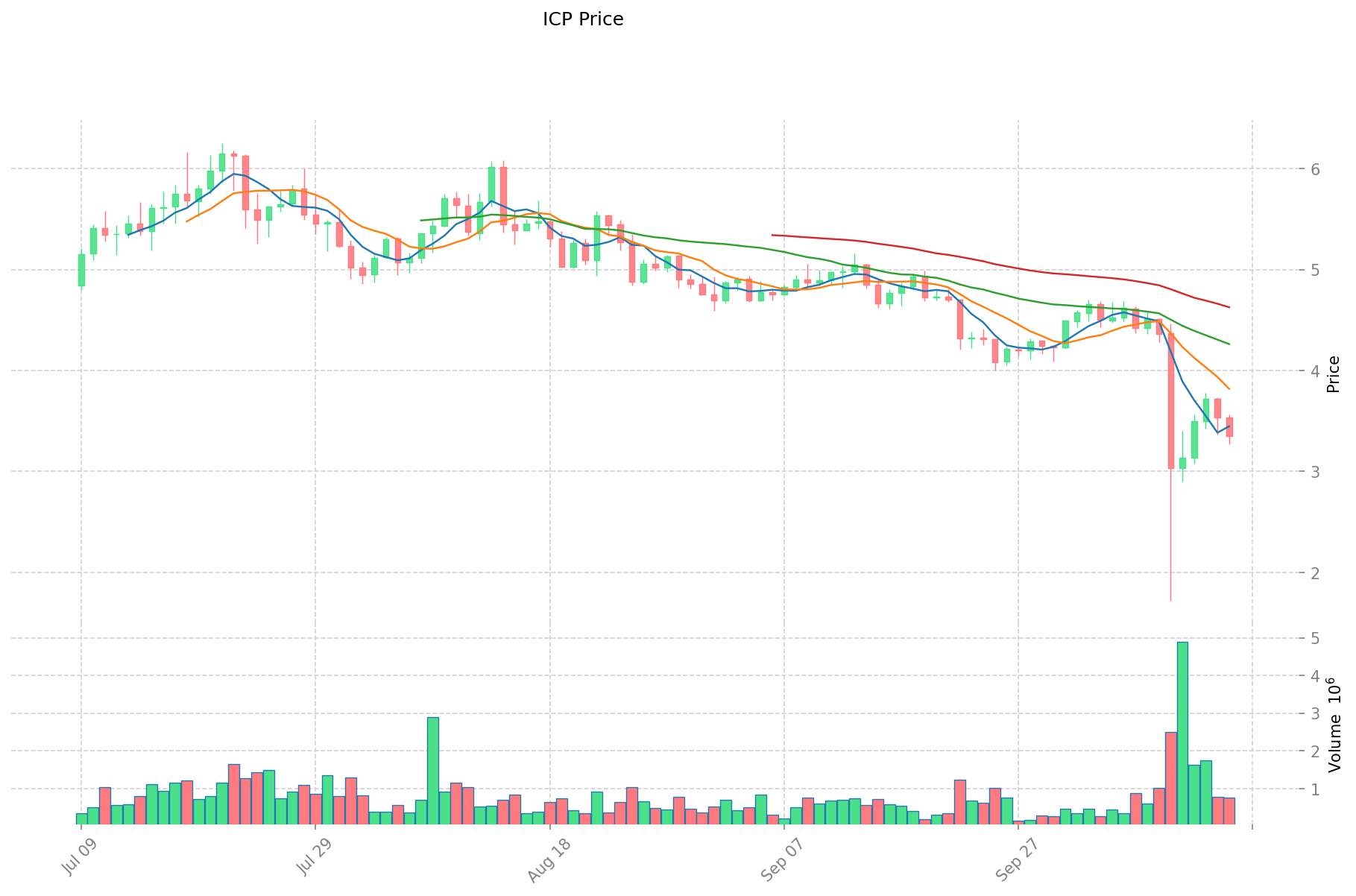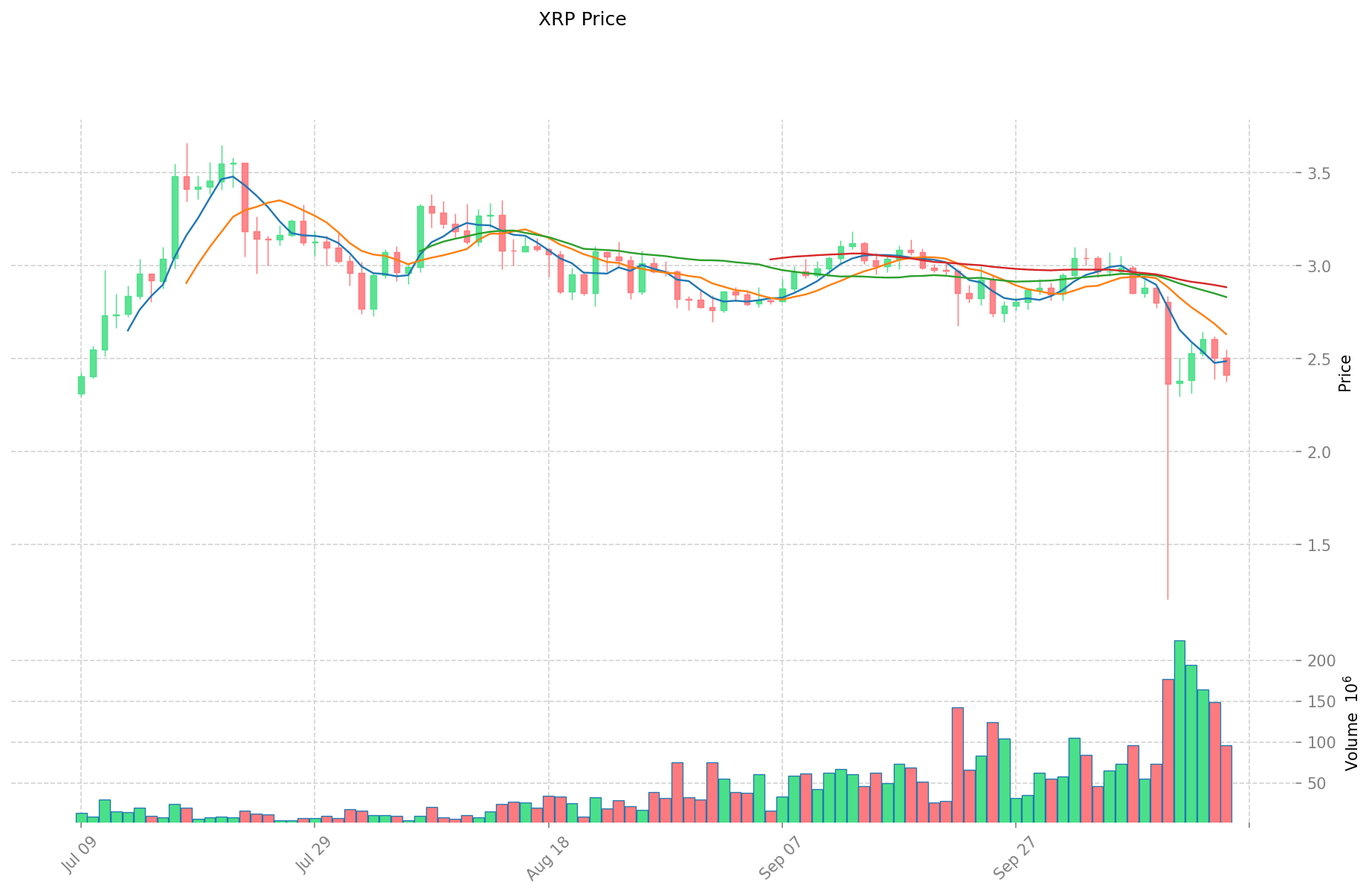ICP vs XRP: A Battle of Blockchain Titans in the Digital Asset Arena
Introduction: ICP vs XRP Investment Comparison
In the cryptocurrency market, Internet Computer (ICP) vs XRP comparison has always been a topic that investors can't avoid. The two not only have significant differences in market cap ranking, application scenarios, and price performance, but also represent different cryptocurrency positioning.
XRP (XRP): Since its launch in 2012, it has gained market recognition for its cross-border payment efficiency.
Internet Computer (ICP): Launched in 2021, it has been hailed as a decentralized public network for running smart contracts at scale, aiming to become an "internet computer" providing public internet functionality.
This article will comprehensively analyze the investment value comparison between ICP and XRP in terms of historical price trends, supply mechanisms, institutional adoption, technical ecosystems, and future predictions, and attempt to answer the question that investors are most concerned about:
"Which is the better buy right now?"
I. Price History Comparison and Current Market Status
Internet Computer (ICP) and XRP (XRP) Historical Price Trends
- 2021: ICP launched at a high price of $700.65, but experienced a significant decline shortly after.
- 2023: XRP saw a surge in price following a favorable court ruling in the SEC lawsuit against Ripple.
- Comparative analysis: During the recent market cycle, ICP dropped from its all-time high of $700.65 to a low of $2.23, while XRP showed more resilience, maintaining a higher price range.
Current Market Situation (2025-10-16)
- ICP current price: $3.344
- XRP current price: $2.409
- 24-hour trading volume: ICP $2,565,908 vs XRP $237,738,873
- Market Sentiment Index (Fear & Greed Index): 34 (Fear)
Click to view real-time prices:
- Check ICP current price Market Price
- Check XRP current price Market Price


ICP vs XRP: Investment Value Analysis
I. Core Factors Affecting ICP vs XRP Investment Value
Supply Mechanism Comparison (Tokenomics)
- XRP: Fixed supply of 100 billion tokens with 99.98 billion already created; no mining mechanism
- ICP: Information not specified in the provided resources
- 📌 Historical Pattern: XRP's fixed supply model creates scarcity which potentially supports value during periods of increased adoption
Institutional Adoption and Market Applications
- Institutional Holdings: XRP has significant institutional support, with SBI Holdings alone holding approximately $10 billion in XRP and Ripple-related assets as of 2025
- Enterprise Adoption: XRP is integrated into cross-border payment systems by financial institutions like SBI Remit, Tranglo, Pyypl, and Banco Rendimento, while ICP adoption details are not specified
- Regulatory Stance: XRP gained regulatory clarity in 2025 when the SEC case was resolved, with XRP being determined not to be a security when sold on exchanges; Japan has maintained favorable regulations for XRP
Technical Development and Ecosystem Building
- XRP Technical Upgrades: XRPL has implemented XLS-20 for native NFTs and proposed XLS-70/XLS-80 for enhanced digital credentials and permission domain controls
- ICP Technical Development: Not specified in the provided resources
- Ecosystem Comparison: XRP's ecosystem includes cross-border payments, loyalty programs, and tourism applications; transactions settle in 3-5 seconds with minimal fees, making it suitable for micropayments and rewards systems
Macroeconomic Factors and Market Cycles
- Performance in Inflationary Environments: Not explicitly addressed in the resources
- Monetary Policy Impact: Resources indicate that Federal Reserve interest rate decisions influence crypto markets broadly, including both assets
- Geopolitical Factors: XRP shows strength in emerging markets for remittances between regions like Southeast Asia, Middle East, Africa, and Latin America
II. Real-World Utility Analysis
Cross-Border Payment Efficiency
- XRP eliminates pre-funding requirements, reduces settlement times to seconds versus days with SWIFT, and serves as a bridge currency
- XRP's utility in cross-border payments is demonstrated through partnerships with financial institutions globally
- ICP's utility in cross-border payments is not mentioned in the provided resources
Integration with Existing Financial Systems
- XRP has been tested and integrated by major banks including Santander and potentially Bank of America
- SBI Group's cryptocurrency exchanges (SBI VC Trade and BITPoint Japan) account numbers grew from approximately 807,000 in March 2024 to 1.65 million in March 2025
- By 2025, XRP had 6.6 million active wallets globally with over 6 million total XRPL accounts
Customer Adoption Metrics
- XRP is being used in loyalty and tourism sectors, with Webus/Wetour establishing a $300 million XRP reserve to support blockchain-based tourism vouchers and rewards
- Over 60 million loyalty members will be able to use XRP for overseas services like airport transfers and travel experiences
III. 2025-2030 Price Prediction: ICP vs XRP
Short-term Prediction (2025)
- ICP: Conservative $1.81 - $3.36 | Optimistic $3.36 - $4.80
- XRP: Conservative $2.17 - $2.41 | Optimistic $2.41 - $3.35
Mid-term Prediction (2027)
- ICP may enter a growth phase, with expected price range $2.88 - $5.31
- XRP may enter a growth phase, with expected price range $2.86 - $4.23
- Key drivers: Institutional capital inflow, ETF, ecosystem development
Long-term Prediction (2030)
- ICP: Base scenario $3.76 - $6.38 | Optimistic scenario $6.38 - $7.47
- XRP: Base scenario $3.37 - $5.35 | Optimistic scenario $5.35 - $6.16
Disclaimer
ICP:
| 年份 | 预测最高价 | 预测平均价格 | 预测最低价 | 涨跌幅 |
|---|---|---|---|---|
| 2025 | 4.80051 | 3.357 | 1.81278 | 0 |
| 2026 | 4.77214335 | 4.078755 | 2.6104032 | 22 |
| 2027 | 5.31053901 | 4.425449175 | 2.87654196375 | 32 |
| 2028 | 7.058591434125 | 4.8679940925 | 3.40759586475 | 45 |
| 2029 | 6.79815375017625 | 5.9632927633125 | 3.5779756579875 | 78 |
| 2030 | 7.465446210390918 | 6.380723256744375 | 3.764626721479181 | 91 |
XRP:
| 年份 | 预测最高价 | 预测平均价格 | 预测最低价 | 涨跌幅 |
|---|---|---|---|---|
| 2025 | 3.35129 | 2.411 | 2.1699 | 0 |
| 2026 | 3.3421282 | 2.881145 | 1.75749845 | 19 |
| 2027 | 4.231825776 | 3.1116366 | 2.862705672 | 29 |
| 2028 | 5.06698903944 | 3.671731188 | 3.34127538108 | 52 |
| 2029 | 6.335572164894 | 4.36936011372 | 3.932424102348 | 81 |
| 2030 | 6.15533606020305 | 5.352466139307 | 3.37205366776341 | 122 |
IV. Investment Strategy Comparison: ICP vs XRP
Long-term vs Short-term Investment Strategy
- ICP: Suitable for investors focused on decentralized cloud computing potential
- XRP: Suitable for investors interested in cross-border payments and financial institution adoption
Risk Management and Asset Allocation
- Conservative investors: ICP: 30% vs XRP: 70%
- Aggressive investors: ICP: 50% vs XRP: 50%
- Hedging tools: Stablecoin allocation, options, cross-currency portfolios
V. Potential Risk Comparison
Market Risk
- ICP: Higher volatility due to newer market entry and limited track record
- XRP: Exposure to fluctuations in cross-border payment demand and competition from CBDCs
Technical Risk
- ICP: Scalability, network stability
- XRP: Centralization concerns, potential security vulnerabilities
Regulatory Risk
- Global regulatory policies may affect both differently, with XRP having gained more regulatory clarity
VI. Conclusion: Which Is the Better Buy?
📌 Investment Value Summary:
- ICP advantages: Potential in decentralized cloud computing, newer technology with room for growth
- XRP advantages: Established cross-border payment use case, institutional adoption, regulatory clarity
✅ Investment Advice:
- New investors: Consider a higher allocation to XRP due to its established market position and clearer use case
- Experienced investors: Balanced approach with both ICP and XRP, leveraging potential growth in both sectors
- Institutional investors: Focus on XRP for its regulatory clarity and existing financial institution partnerships
⚠️ Risk Warning: The cryptocurrency market is highly volatile, and this article does not constitute investment advice. None
VII. FAQ
Q1: What are the main differences between ICP and XRP in terms of their use cases? A: ICP focuses on decentralized cloud computing and smart contracts, while XRP specializes in cross-border payments and financial institution integration.
Q2: Which cryptocurrency has shown more price stability historically? A: Based on the provided information, XRP has demonstrated more price resilience compared to ICP, maintaining a higher price range during recent market cycles.
Q3: How does institutional adoption compare between ICP and XRP? A: XRP has significant institutional support, with major financial institutions integrating it into their systems. ICP's institutional adoption is not specified in the provided information.
Q4: What are the key regulatory considerations for ICP and XRP? A: XRP gained regulatory clarity in 2025 when it was determined not to be a security when sold on exchanges. ICP's regulatory status is not explicitly mentioned in the provided context.
Q5: How do the supply mechanisms of ICP and XRP differ? A: XRP has a fixed supply of 100 billion tokens with 99.98 billion already created and no mining mechanism. ICP's supply mechanism is not specified in the provided information.
Q6: Which cryptocurrency might be more suitable for long-term investment? A: Both have potential, but XRP may be more suitable for long-term investment due to its established use case in cross-border payments, institutional adoption, and regulatory clarity.
Q7: What are the predicted price ranges for ICP and XRP by 2030? A: For ICP, the predicted range is $3.76 - $7.47. For XRP, the predicted range is $3.37 - $6.16, depending on market conditions and adoption rates.
Share
Content